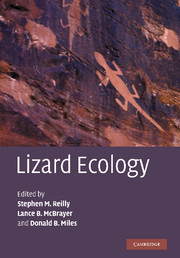Book contents
- Frontmatter
- Contents
- List of contributors
- Preface
- Historical introduction: on widely foraging for Kalahari lizards
- I Organismal patterns of variation with foraging mode
- 1 Movement patterns in lizards: measurement, modality, and behavioral correlates
- 2 Morphology, performance, and foraging mode
- 3 Physiological correlates of lizard foraging mode
- 4 Lizard energetics and the sit-and-wait vs. wide-foraging paradigm
- 5 Feeding ecology in the natural world
- 6 Why is intraspecific niche partitioning more common in snakes than in lizards?
- 7 Herbivory and foraging mode in lizards
- 8 Lizard chemical senses, chemosensory behavior, and foraging mode
- 9 Patterns of head shape variation in lizards: morphological correlates of foraging mode
- 10 Prey capture and prey processing behavior and the evolution of lingual and sensory characteristics: divergences and convergences in lizard feeding biology
- 11 The meaning and consequences of foraging mode in snakes
- II Environmental influences on foraging mode
- Index
- References
8 - Lizard chemical senses, chemosensory behavior, and foraging mode
Published online by Cambridge University Press: 04 August 2010
- Frontmatter
- Contents
- List of contributors
- Preface
- Historical introduction: on widely foraging for Kalahari lizards
- I Organismal patterns of variation with foraging mode
- 1 Movement patterns in lizards: measurement, modality, and behavioral correlates
- 2 Morphology, performance, and foraging mode
- 3 Physiological correlates of lizard foraging mode
- 4 Lizard energetics and the sit-and-wait vs. wide-foraging paradigm
- 5 Feeding ecology in the natural world
- 6 Why is intraspecific niche partitioning more common in snakes than in lizards?
- 7 Herbivory and foraging mode in lizards
- 8 Lizard chemical senses, chemosensory behavior, and foraging mode
- 9 Patterns of head shape variation in lizards: morphological correlates of foraging mode
- 10 Prey capture and prey processing behavior and the evolution of lingual and sensory characteristics: divergences and convergences in lizard feeding biology
- 11 The meaning and consequences of foraging mode in snakes
- II Environmental influences on foraging mode
- Index
- References
Summary
Introduction
Even to casual observers, one of the most obvious things about lizards is tongue-flicking. The form and frequency of tongue-flicking vary greatly among lizard species, but all do it. No other animals do. Even tuataras, the closest living relatives of squamate reptiles and sole survivors of Rhynchocephalia, do not tongue-flick (Schwenk, 1986, 1993a; Cooper et al., 2001a). Biologists have suggested several functions for tongue-flicking in lizards and snakes, including sensory functions such as gustation (Schwenk, 1985), touch (Klauber, 1956; Bodnar et al., 1975), detection of airborne vibration (Ditmars, 1937; Klauber, 1956), and chemoreception. Some lizards extend the tongue as part of antipredatory displays (Greene, 1988), and the author F. Scott Fitzgerald (1945), undoubtedly based on frequent tongue-flicking during courtship by some species, has likened tongue-flicks to a kiss:
The kiss originated when the first male reptile licked the first female, implying in a subtle, complimentary way that she was as succulent as the small reptile he had for dinner the night before.
All of the available evidence suggests that the primary function of tongue-flicking is chemosensory. It has been amply demonstrated that lizards can detect food, predators, and conspecifics by tongue-flicking (Halpern, 1992; Mason, 1992; Cooper, 1997a; Downes and Shine, 1998). The tongue bears variable numbers of taste buds in lizards, but not in snakes, suggesting possible use of tongue-flicking to taste potential foods and other stimulus sources (Schwenk, 1985).
- Type
- Chapter
- Information
- Lizard Ecology , pp. 237 - 270Publisher: Cambridge University PressPrint publication year: 2007
References
- 12
- Cited by



